The Whitsunday Islands, located off the coast of Queensland, Australia, are a stunning archipelago of 74 islands renowned for their breathtaking beauty and pristine natural environment. Nestled in the heart of the Great Barrier Reef, a UNESCO World Heritage site, these islands are a geological and natural wonder, offering a unique combination of lush rainforests, white sandy beaches, and vibrant coral reefs.
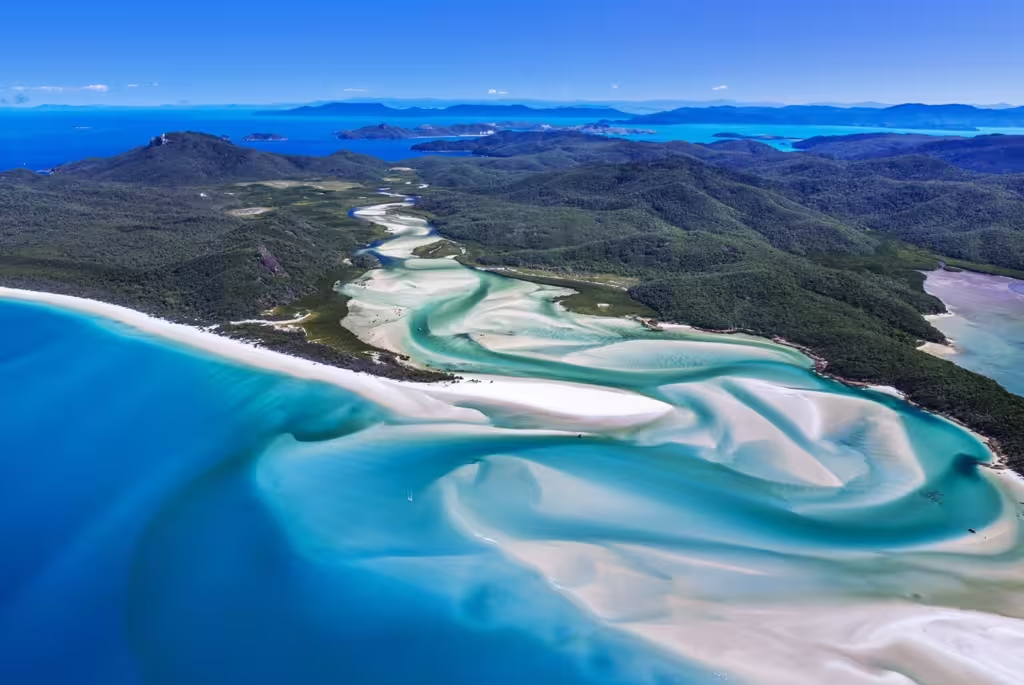
The Whitsundays hold great importance as a natural sanctuary, home to diverse marine life and some of the world’s most spectacular coral formations. The islands’ pristine ecosystems are a haven for wildlife enthusiasts, snorkelers, and sailors alike, providing an unparalleled opportunity to explore one of Earth’s most remarkable marine environments.
Located approximately 900 kilometers north of Brisbane and 600 kilometers south of Cairns, the Whitsunday Islands are easily accessible by air, with the nearest airport in Proserpine (Whitsunday Coast Airport) and regular flights from major Australian cities. Additionally, the islands can be reached by ferry or private yacht, making them a popular destination for tourists seeking adventure, relaxation, or a chance to experience the natural beauty of Australia.
Contents
Formation of the Whitsunday Islands

The Whitsunday Islands have a fascinating geological history rooted in volcanic activity and tectonic shifts. Around 110 million years ago, during the late Mesozoic Era, the region that now comprises the Whitsundays was shaped by significant volcanic activity. The islands themselves are the remnants of ancient volcanic mountains, which were formed by intense eruptions and subsequent lava flows. Over millions of years, tectonic forces continued to influence the landscape, causing the Earth’s crust to fracture and shift, further sculpting the terrain.
The islands are relatively ancient, with their formation dating back to this period of volcanic activity. Over time, as sea levels rose and fell, the once-connected landmass was gradually eroded and submerged, leaving behind the scattered islands we see today. The surrounding waters of the Coral Sea flooded the low-lying areas, creating the archipelago of 74 islands.
The Great Barrier Reef has played a crucial role in shaping the Whitsunday Islands. As the world’s largest coral reef system, it acts as a natural barrier that protects the islands from the direct impact of oceanic waves and storms. This protection has allowed the islands to maintain their stunning beaches and vibrant coral reefs, while also supporting the growth of the coral ecosystems that fringe the islands. The reef’s presence has also contributed to the islands’ unique marine environment, fostering a rich biodiversity that is both ecologically significant and visually spectacular.
Unique Geological Features of the Whitsunday Islands
The Whitsunday Islands boast several unique geological features that make them stand out as a natural wonder. These features are the result of millions of years of volcanic activity, tectonic shifts, and the ongoing influence of the Great Barrier Reef.
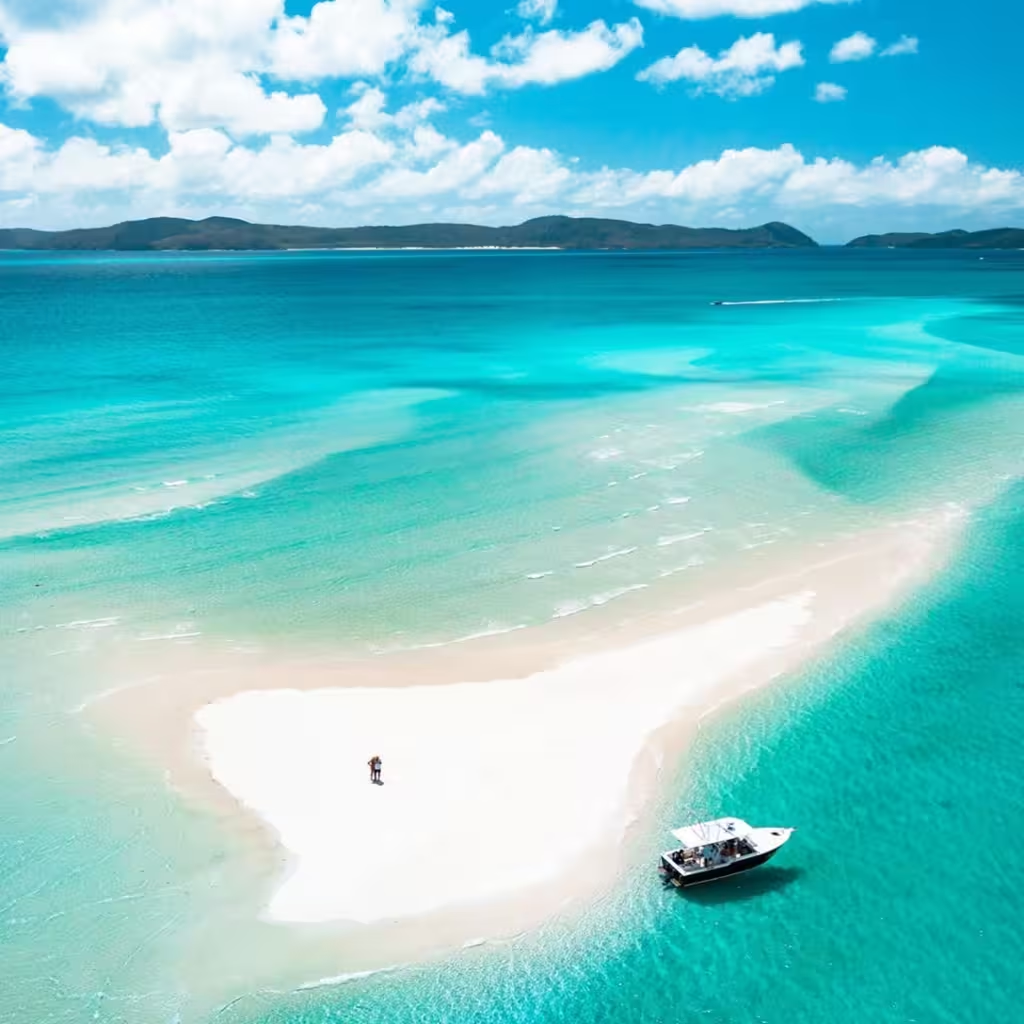
Whitehaven Beach and Silica Sands: One of the most famous geological features of the Whitsundays is Whitehaven Beach on Whitsunday Island. The beach is renowned for its pure white silica sand, which is 98% pure silica. Unlike most sands, which are composed of fragments of coral, shell, and volcanic rock, Whitehaven’s sand is almost entirely made of quartz, giving it a brilliant white color and a fine, powdery texture. The sand does not retain heat, making it comfortable to walk on even in the hottest sun.
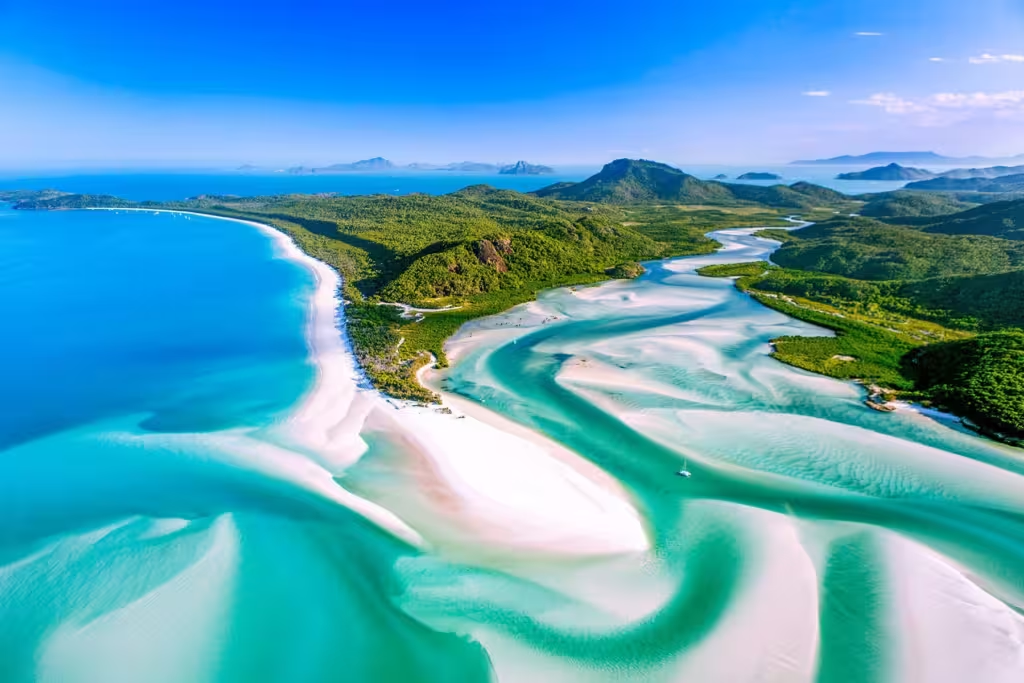
Hill Inlet: At the northern end of Whitehaven Beach, Hill Inlet is a breathtaking natural phenomenon where the tides shift the sand and water to create a swirling fusion of colors. This tidal estuary, with its shifting patterns of turquoise waters and white sand, is a dynamic and ever-changing landscape that highlights the unique interaction between the island’s geography and the surrounding marine environment.
Island Composition and Topography: The Whitsunday Islands themselves are the peaks of a submerged mountain range, with many islands featuring rugged hills, cliffs, and forested areas. The islands are composed mainly of volcanic rock, with some areas showing the basaltic lava flows that formed during their volcanic past. The topography varies across the islands, with some featuring steep, mountainous terrain, while others have flatter, more gently sloping landscapes.
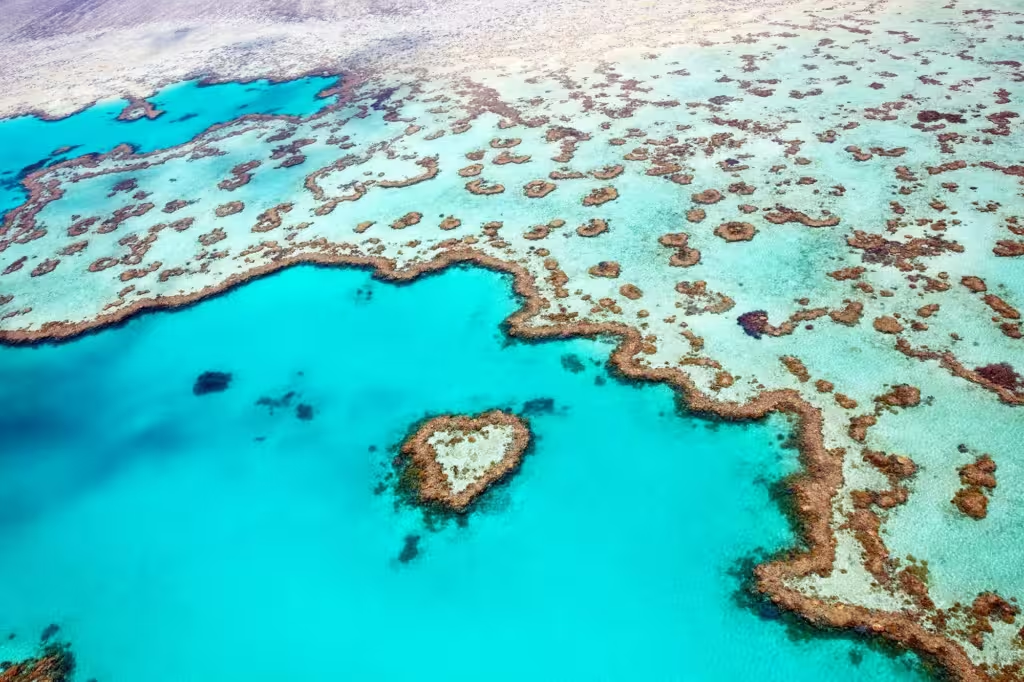
Coral Reefs: Surrounding the islands are vibrant coral reefs that are part of the Great Barrier Reef system. These reefs are among the most diverse ecosystems on the planet, built over millennia by tiny coral polyps. The reefs around the Whitsundays are home to a wide variety of marine life, and their structure plays a critical role in protecting the islands from erosion and shaping their coastlines.
Nara Inlet Caves: On Hook Island, the Nara Inlet caves hold significant archaeological and geological interest. These caves contain ancient Aboriginal rock art, making them not only a geological feature but also a cultural one. The caves themselves were formed through natural processes of erosion and provide insights into the geological history of the area, as well as its long-standing human occupation.
These features make the Whitsunday Islands a remarkable destination for geologists, ecologists, and tourists alike, offering a rare glimpse into the Earth’s dynamic geological processes and the beauty they create.
Biodiversity and Ecosystem of the Whitsunday Islands
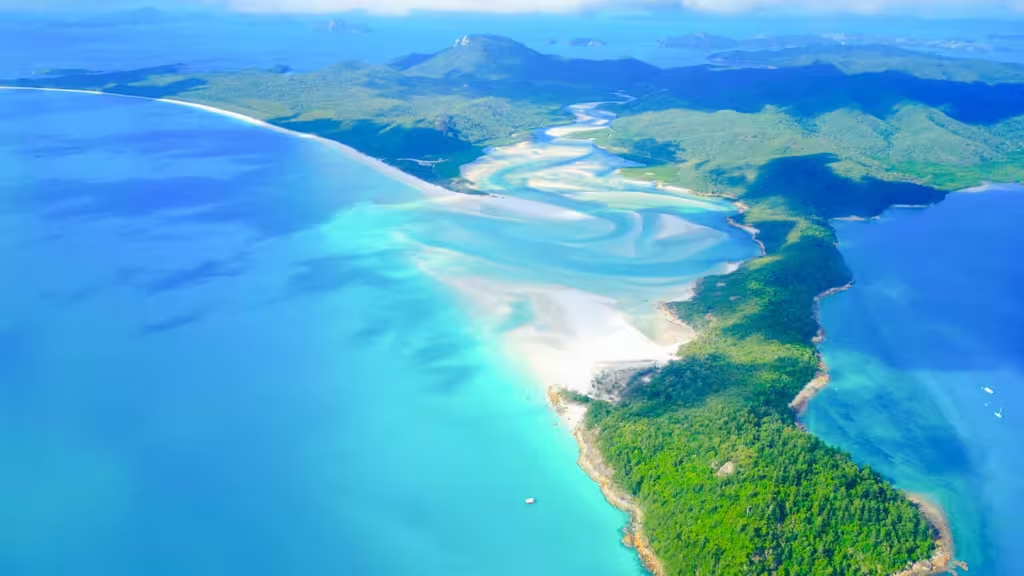
The Whitsunday Islands are not only a geological marvel but also a hotspot for biodiversity, offering a rich and diverse ecosystem both on land and in the surrounding marine environment. This unique blend of habitats supports a wide variety of plant and animal species, many of which are endemic or of significant ecological importance.
- Marine Ecosystem:
- Coral Reefs: The coral reefs surrounding the Whitsundays are part of the Great Barrier Reef, the world’s largest coral reef system. These reefs are home to a staggering variety of marine life, including over 1,500 species of fish, 400 types of coral, and numerous species of mollusks, echinoderms, and crustaceans. Iconic species such as clownfish, parrotfish, and the giant clam can be found here, as well as several species of sea turtles, including the green, loggerhead, and hawksbill turtles.
- Marine Mammals and Megafauna: The waters around the Whitsundays are also a haven for larger marine species. Humpback whales migrate through the area from June to September, using the warm waters as a breeding ground. Dolphins, dugongs, and manta rays are also commonly sighted, adding to the region’s rich marine biodiversity.
- Mangroves and Seagrass Beds: The coastal areas of the islands are lined with mangrove forests and seagrass beds, which are crucial for maintaining the health of the marine ecosystem. These habitats provide nursery grounds for young fish and crustaceans and play a key role in stabilizing the coastline against erosion.
- Terrestrial Ecosystem:
- Rainforests: The interior of several Whitsunday Islands, particularly on larger islands like Whitsunday Island and Hook Island, is covered in lush, subtropical rainforest. These rainforests are home to a variety of plant species, including ferns, orchids, and fig trees, as well as unique flora such as the Whitsunday bottle tree. The dense vegetation provides a habitat for numerous bird species, including the white-bellied sea eagle, pied imperial-pigeon, and several species of honeyeaters.
- Wildlife: The islands are home to a range of terrestrial animals, including several species of reptiles, such as the sand monitor and various skinks, as well as a few species of mammals, like the common brushtail possum. The islands are also an important stopover for migratory birds, making them a key site for birdwatching.
- Endemic and Threatened Species:
- Proserpine Rock-Wallaby: One of the most notable species in the Whitsundays is the Proserpine rock-wallaby, which is endemic to the region. This small marsupial is adapted to the rocky outcrops found on some of the islands and is considered vulnerable due to habitat loss and predation by introduced species.
- Coral Species: The coral reefs around the Whitsundays support a variety of hard and soft coral species, some of which are threatened by climate change and coral bleaching. Efforts are being made to protect and preserve these vital ecosystems through marine conservation programs.
- Conservation Efforts:
- The Whitsunday Islands are protected within the Great Barrier Reef Marine Park, and several areas are designated as national parks. These protections help to preserve the unique biodiversity of the region, ensuring that the delicate ecosystems are maintained for future generations. Conservation programs focus on monitoring reef health, protecting endangered species, and managing the impacts of tourism.
The Whitsunday Islands’ rich biodiversity and complex ecosystems make them a vital part of Australia’s natural heritage, offering a sanctuary for wildlife and a unique environment where the interplay of land and sea creates a vibrant, living landscape.
Human Interaction and Cultural Significance of the Whitsunday Islands

The Whitsunday Islands have a rich history of human interaction and cultural significance, from their early Aboriginal inhabitants to their role as a popular tourist destination today. The islands’ cultural heritage, combined with their stunning natural environment, makes them a place of deep meaning and importance.
1. Indigenous Heritage:
- Traditional Custodians: The Whitsunday Islands hold significant cultural and spiritual value for the Ngaro people, who are the traditional custodians of the land. The Ngaro have inhabited the region for thousands of years, relying on the islands’ abundant natural resources for their livelihood. Their connection to the land and sea is deeply rooted in their cultural practices, stories, and traditions.
- Rock Art and Archaeological Sites: The islands are home to several important archaeological sites, including ancient rock art and middens that provide insight into the Ngaro people’s way of life. The Nara Inlet on Hook Island, for example, features rock art that dates back over 9,000 years, depicting marine life and cultural symbols. These sites are vital to understanding the long history of human occupation in the region and are preserved as part of the cultural heritage of the Whitsundays.
2. European Exploration and Settlement:
- James Cook’s Expedition: The Whitsunday Islands were named by Captain James Cook, who sailed through the passage between the islands on Whitsunday in 1770. Cook’s exploration marked the beginning of European interest in the region, although the islands were not settled immediately.
- Colonial Impact: During the 19th century, European settlers began to exploit the natural resources of the islands and surrounding waters. This included logging the islands’ timber and harvesting marine resources such as sea cucumbers. The arrival of Europeans had a profound impact on the Indigenous populations, leading to displacement and significant cultural changes.
3. Modern Tourism and Development:
- Tourism Industry: Today, the Whitsunday Islands are one of Australia’s most popular tourist destinations, attracting visitors from around the world. The islands’ pristine beaches, clear waters, and rich marine life make them a prime location for activities such as sailing, snorkeling, diving, and hiking. The tourism industry is a major economic driver for the region, with numerous resorts, tour operators, and recreational facilities catering to visitors.
- Environmental Management: The rise in tourism has necessitated careful management to protect the islands’ fragile ecosystems. The Great Barrier Reef Marine Park Authority (GBRMPA) oversees the preservation of the natural environment, implementing regulations to minimize the impact of tourism and ensure sustainable practices. Efforts include monitoring reef health, managing visitor numbers, and educating tourists about responsible behavior.
4. Cultural Significance and Conservation:
- Preservation of Cultural Sites: The cultural sites of the Whitsundays, including Indigenous rock art and historical landmarks, are protected by both state and federal heritage laws. These efforts are crucial for maintaining the cultural integrity of the islands and allowing future generations to connect with their historical significance.
- Cultural Tourism: Increasingly, there is a focus on promoting cultural tourism that highlights the Indigenous heritage of the Whitsundays. Visitors can engage with the rich cultural history of the islands through guided tours, storytelling sessions, and visits to sacred sites, providing a deeper understanding of the area’s significance.
5. Contemporary Significance:
- Cultural Revival and Awareness: There is a growing movement to revive and celebrate the Indigenous culture of the Whitsundays. This includes efforts to educate both locals and visitors about the Ngaro people’s connection to the land, their cultural practices, and the importance of preserving their heritage.
- Sustainable Development: The future of the Whitsunday Islands lies in balancing tourism with environmental and cultural preservation. Initiatives aimed at sustainable development are increasingly important, ensuring that the natural beauty and cultural significance of the islands are protected for future generations.
The Whitsunday Islands are a place where natural beauty and cultural heritage intersect, creating a unique environment where the past and present are inextricably linked. From the ancient traditions of the Ngaro people to the modern-day challenges of tourism and conservation, the islands continue to be a place of deep cultural significance and human interaction.
Threats to the Geological Integrity of the Whitsunday Islands
The Whitsunday Islands, while renowned for their natural beauty and unique geological features, face several threats that could compromise their geological integrity. These threats primarily stem from climate change and human activities, both of which pose significant challenges to the preservation of this delicate environment.
1. Climate Change and Its Impact on Geological Features:
- Rising Sea Levels: One of the most immediate and concerning impacts of climate change on the Whitsunday Islands is rising sea levels. As global temperatures increase, polar ice melts, and ocean waters expand, the islands are at risk of coastal erosion and submersion. Rising sea levels can erode beaches, particularly the iconic Whitehaven Beach, and alter the natural landscapes that have been shaped over millions of years.
- Coral Bleaching and Reef Degradation: The surrounding coral reefs, which play a crucial role in protecting the islands and shaping their coastlines, are highly sensitive to changes in sea temperature. Warmer waters can cause coral bleaching, where corals expel the symbiotic algae that give them color and energy, leading to widespread reef degradation. The loss of coral reefs can destabilize the islands’ marine ecosystems and reduce their natural defenses against wave action and storms.
- Increased Frequency of Severe Weather Events: Climate change is also linked to more frequent and intense weather events, such as cyclones. These storms can cause significant physical damage to the islands’ geological features, including landslides, coastal erosion, and the destruction of fragile ecosystems. The long-term impact of these events could lead to permanent changes in the islands’ landscapes.
2. Human Activities: Tourism, Pollution, and Their Effects:
- Tourism Pressure: The Whitsunday Islands are a major tourist destination, with thousands of visitors arriving each year to experience the natural beauty of the region. While tourism is vital to the local economy, it also puts immense pressure on the islands’ ecosystems. Overcrowding can lead to physical damage to fragile environments, such as trampling of vegetation, disruption of wildlife, and erosion of walking trails and beaches.
- Pollution: Human activities associated with tourism, such as boating, snorkeling, and resort development, can contribute to pollution in the islands. Plastic waste, oil spills, and chemical runoff from boats and resorts can degrade the quality of the marine environment and threaten both marine and terrestrial ecosystems. Pollution can also accelerate the deterioration of coral reefs and harm the diverse marine life that depends on them.
- Anchoring and Marine Traffic: The anchoring of boats and increased marine traffic can cause direct physical damage to the seabed, particularly to sensitive coral reefs and seagrass beds. Anchors can break apart coral structures and disrupt the habitats of various marine species, leading to long-term ecological impacts.
3. Conservation Challenges and Future Outlook:
- Balancing Tourism and Conservation: One of the most significant challenges in the Whitsunday Islands is finding a balance between promoting tourism and protecting the natural environment. While tourism is economically beneficial, it requires strict regulation and management to ensure that it does not lead to irreversible damage to the islands’ geological and ecological features. Implementing sustainable tourism practices, such as limiting visitor numbers, enforcing no-anchor zones, and promoting eco-friendly activities, is crucial.
- Coral Reef Conservation: Protecting the coral reefs around the Whitsunday Islands is a priority for conservation efforts. This includes ongoing monitoring of reef health, restoration projects for damaged reefs, and initiatives to combat coral bleaching. Additionally, reducing carbon emissions globally is essential to mitigate the broader impacts of climate change on coral reefs and marine ecosystems.
- Erosion Control and Habitat Restoration: Efforts to control erosion and restore damaged habitats are critical for maintaining the geological integrity of the islands. This may involve planting vegetation to stabilize dunes, constructing barriers to protect against storm surges, and rehabilitating areas affected by human activity. Conservation programs often focus on restoring native flora and fauna, which play a key role in preserving the natural landscape.
- Community Engagement and Education: Raising awareness about the importance of conservation and sustainable practices is vital for the long-term protection of the Whitsunday Islands. Engaging local communities, tourists, and stakeholders in conservation efforts helps to foster a sense of responsibility and encourages behaviors that minimize environmental impact.
Future Outlook:
The future of the Whitsunday Islands depends on the success of conservation efforts and the global response to climate change. While the islands face significant challenges, there is hope that with proper management and international cooperation, their unique geological features and ecosystems can be preserved. Continued research, adaptive management strategies, and a commitment to sustainability are essential to safeguarding the Whitsunday Islands for future generations.




































